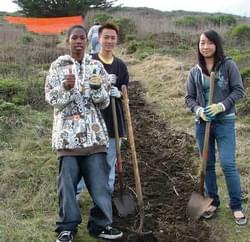




By Greg Moore, Executive Director, Golden Gate National Parks Conservancy
Ponds for the threatened California red-legged frog were built along with new trails for recreation and interpretation at Mori Point along the San Mateo Coast near the town of Pacifica.

Mori Point, a stunning 110-acre promontory in the Golden Gate National Parks located along the San Mateo Coast adjacent to the town of Pacifica, has breathtaking views stretching from Point Reyes to Pedro Point. The work at this site merits strong consideration for the Planning/Design Award because our efforts at Mori Point not only helped improve trails for recreation purposes and enhance rare wildlife habitat, but we were also successful in involving the community in our vision.
This was a unique project because it required reconciling many different interests with many different goals— all against the pressure of a very short construction season (due to the breeding season of rare species of wildlife). There were a wide variety of stakeholders with an interest in this plot of parkland— including the City of San Francisco, the City of Pacifica, the park visitors, and the surrounding community of neighbors whose backyards abut the site. Staff had to hear their needs and desires, integrate and balance that input, and maintain a strong relationship with all parties. At the same time, planning and design of the project at Mori Point had to incorporate goals of natural resource protection, recreational use, interpretation, community involvement, and accessibility, among others.
It was also a particular challenge to work on a site that endured a diverse history of use. In the 1800's this coastal area featured a farm and roadhouse inn; during Prohibition it was a bootlegger’s haven and home to a notorious speakeasy. In more recent years, this site experienced extensive ranching, quarrying, motor-biking, and numerous development proposals, including one for a high-end casino. When Mori Point was transferred to the National Park Service in 2002, the landscape was fragmented by erosion, disturbed habitat, and an unruly network of "social trails."
Despite all these landscape disturbances, Mori Point continues to support a viable population of the endangered San Francisco garter snake and the threatened California red-legged frog. To improve visitor access to Mori Point while supporting the restoration of habitat for sensitive species, this project was launched by Trails Forever (a partnership initiative of the Golden Gate National Parks Conservancy, National Park Service, and Presidio Trust) and the Parks Conservancy’s Site Stewardship Program. Highlights of the work at Mori Point include:
Volunteers have played a huge role in the enhancement of this site. Over 1,400 volunteers have participated in stewardship efforts totaling over 40,000 hours of restoration work on site since 2007.
They have also salvaged over 1,800 native wetland plants from construction areas and planted over 9,000 native plants during the 2007 winter rainy season.
Volunteers have also supported our trail construction efforts by removing non-designated social trails in the area and assisted in the installation of 1,300 square feet of protective fencing along sensitive habitat areas. A regular Saturday volunteer workday significantly helped speed the work on site.
Project Information Coordinators worked on site throughout the project period to keep the public abreast of the construction schedule and trail detours as well as share information about the site’s natural resource values and trail and restoration opportunities. Public meetings and education walks were facilitated by project staff on topics ranging from cultural history to local flora and fauna.
In the coming year, we’re focusing on healing the scarred land by converting former service roads into multi-use trails and addressing the damaged social trails that crisscross the park’s sensitive areas. We have already attracted many visitors to this breathtaking site and the community response has been extremely enthusiastic. Bikers and hikers have mentioned that the consistent tread on the trails now makes for a more enjoyable outdoor experience. Community members and park visitors have been supportive of the social trail decommissioning. In short, the planning and design work at Mori Point has accomplished all of our diverse goals: improve hiking and biking trails for visitors using innovative trail methods, restore sensitive habitat for rare wildlife, meet the needs of community members, and balance their myriad interests in this beautiful coastal site.
1,242 views • posted 09/10/2018